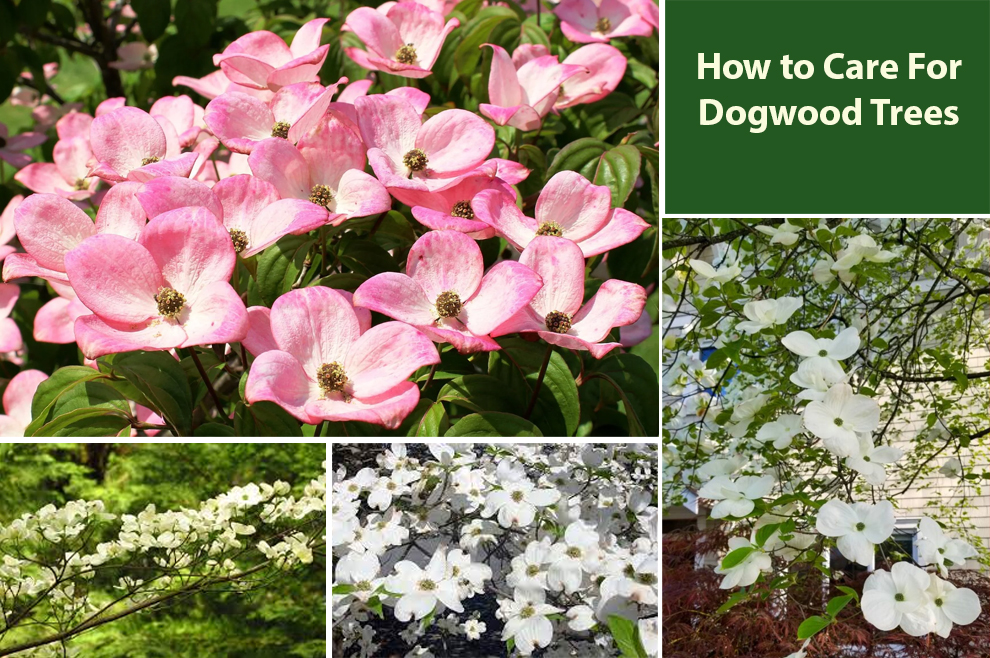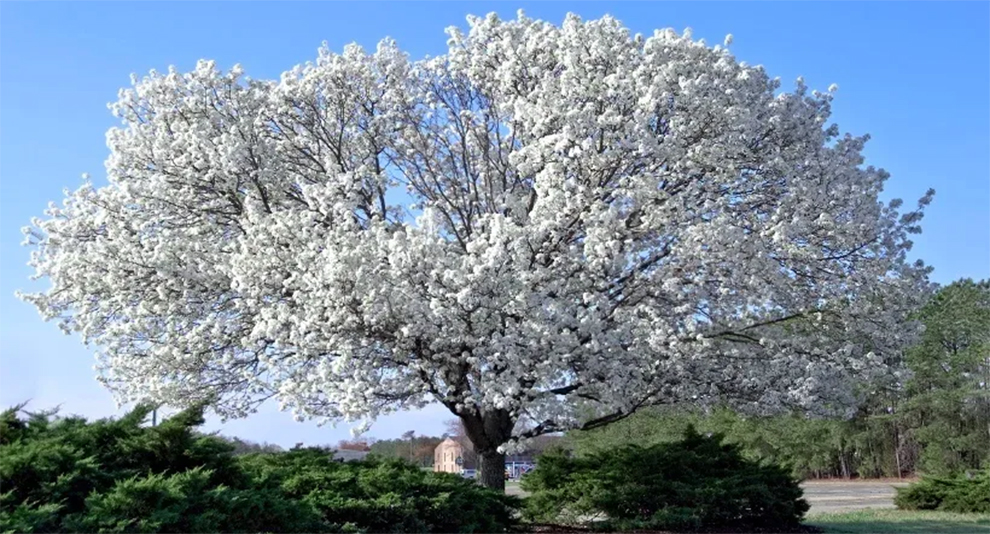Dogwood Tree Care: Growing Conditions For Bushes, Shrubs & Trees
Avoid planting the dogwood trees too deep. Plant them in light shade and water regularly, especially during dry periods. Apply mulch to retain soil moisture and suppress weeds. Prune in late winter to remove dead wood and shape the tree.

Caring for dogwood trees is essential to ensure their health and beauty. With their stunning foliage and attractive blooms, dogwoods make an attractive addition to any landscape.
But these trees need proper attention and maintenance to thrive. For this, you must learn about Dogwood tree care.
Whether you have a flowering dogwood (Cornus florida) or a Pacific dogwood (Cornus nuttallii), following a few vital care instructions help the tree flourish.
Dogwoods prefer partial shade and well-drained soil, making them suitable for various climates. Regular mulching, watering, and feeding are also imperative for their growth.
Further, pruning damaged or dead branches and guarding them against pests and diseases is also crucial. By dedicating some effort and time, you can ensure your dogwood trees remain vibrant, healthy, and a source of joy for years.
How To Care For Dogwood Trees – Comprehensive Care Guide
Typically, Dogwood tree varieties are low-maintenance, but they still need some effort to thrive. In this comprehensive care guide, we will take you through crucial steps to ensure the healthy growth of the dogwood trees.
A. Choosing a variety that is pest resistant
Picking a pest-resistant dogwood tree species is crucial to ensure their overall health and lower the need for extensive pest control. You can find many dogwood tree types with a natural resistance to common pests like scale insects, borers, and powdery mildew.
Some prevalent pest-resistant dogwood species include the hybrid Stellar Pink dogwood (Cornus x rutgersensis Rutgan) and the Kousa dogwood (Cornus kousa).
These dogwood varieties have depicted increased resistance to several diseases and pests than other species. For minimum dogwood shrub care, you must consult a local horticulturist or a nursery to identify the best pest-resistant options suitable for your region.
By picking the right variety, you can reduce pest-related issues and lower the need for extensive pest control measures.
B. Picking the best possible location for Dogwoods
Choosing the correct location for the dogwood trees is also imperative for its overall well-being and growth. Dogwoods thrive in partial shade, making them excellent for planting under larger trees or on the north or east side of buildings where they can receive morning sun and afternoon shade.
Ensure the chosen spot has well-drained soil to avoid waterlogged roots, as dogwoods are susceptible to root rot. Keep them away from areas with heavy clay soil or locations likely to flood.
Further, consider the mature tree’s size and ensure it has ample space to spread its branches without being crowded by nearby structures or other plants. By planting them in an apt location with the right sun and well-drained soil, you can offer optimal dogwood tree care for your plants to flourish.
C. How much sun does a dogwood tree need?

Dogwood trees cherish partial shade to full sun. However, the amount of sun they require can vary depending on the regional climate and the specific variety.
Ideally, dogwood trees must receive about four to six hours of direct sun daily. Morning sun is typically preferred for dogwood bush care, as it helps dry dew from the leaves and lowers the risk of fungal diseases.
But dogwoods can endure full sun, provided they receive ample moisture and are not exposed to extreme heat. Provide afternoon shade in a hot climate to guard your trees against scorching.
D. What climate do dogwood trees grow in? (Temp & Humidity)
Dogwood trees are adaptable to different climates, but they typically thrive in temperate regions with moderate humidity and temperatures.
You will spot dogwood trees in USDA hardiness zones five through nine. It encompasses many areas across North America.
In terms of temperature, dogwood tree growing conditions are pretty manageable. The plant needs average to cool climates. They can endure temperatures as low as 20°F (-29°C) in colder zones.
As for the warmer zones, they seek summer temperatures up to 90°F (32°C). But prolonged or extreme heat or frost periods can stress the tree and badly influence their health.
Dogwoods seek moderate levels of humidity. They thrive in areas with average to high humidity but can endure drier conditions once established. Adequate moisture is necessary during the growing season to support their health and growth.
E. What kind of soil do dogwood trees like?
Dogwood trees demand well-drained soil rich in organic matter. Here are a few characteristics of suitable soil for dogwood trees:
- Dogwoods thrive in soil that retains moisture but does not become waterlogged. Do not plant them in heavy clay soils or soils susceptible to waterlogging. It may result in root rot and other problems.
- Dogwoods cherish soil with a pH range between 5.5 and 6.5. Amending the soil with organic matter or peat moss is crucial for dogwood shrub care if your soil is alkaline. It can help lower the pH and create a more conducive environment.
- Good drainage is also crucial for dogwood trees. Soil that holds too much water can result in root suffocation and diseases. Amend the soil with organic matter and create mounds or raised beds for better drainage if it is heavy clay soil.
- Adding organic matter such as well-rotted manure or compost to the soil helps better fertility, structure, and moisture-retention capacity. It is essential during planting and when prepping the planting hole.
You can create optimal growing conditions for dogwood trees and support their vigor and health with slightly acidic, well-drained soil with ample organic matter.
Performing a soil assessment test can help plan your soil and offer suitable dogwood tree growing conditions.
F. Mulching
Mulching is imperative for dogwood trees as it offers several benefits to their growth and health. Here are some factors to consider when mulching dogwood trees:
- Use organic mulch materials, like bark, wood chips, compost, or shredded leaves. These materials break down, adding organic matter to the soil and boosting fertility.
- Apply a thick mulch layer around the tree’s base extending it to the drip line. The mulch layer must be approximately two to four inches deep. Leave a small gap around the trunk to avoid moisture buildup and prevent diseases and pests.
- Mulching helps conserve soil moisture by lowering evaporation, maintaining a consistent soil temperature, and preventing weed growth. It is a buffer against extreme temperature fluctuations, guarding the roots from heat and cold stress.
- Regularly examine the mulch layer and replenish it as it decomposes gradually. Do not pile mulch against the trunk because it can create a conducive environment for diseases or pests.
G. Does Dogwood need a lot of water?
Dogwood trees need regular watering, especially during dry and establishment periods. However, they do not require excessive amounts of water once they are well-established.
Here are some considerations regarding watering dogwood:
- Newly planted dogwood trees seek consistent moisture to encourage root development and establishment. You can water at least once a week during the first year, providing them ample water to moisten the soil to a depth of six to eight inches.
- They become moderately drought-tolerant once established (typically after the first year). But during extended periods of extreme heat or dry spells, supplemental water helps. Water deeply to moisten the top six to twelve inches whenever the top two to three inches are dry.
- Do not overwater because dogwoods are susceptible to root rot if the soil remains waterlogged.
H. Dogwood fertilizers
Feeding dogwood trees with the correct nourishment is vital for dogwood bush care. It helps promote vibrant foliage and healthy growth. Here are some crucial considerations:
- Apply the plant food in early spring before new growth starts to let the trees employ the nutrients during the active growth period.
- Use a slow-release, balanced or controlled-release fertilizer exquisitely formulated for shrubs and trees. Go with a fertilizer with a 14-14-14 or a 10-10-10 NPK.
- Follow the packaging instructions for the application rate based on your dogwood’s variety, size, and age.
- Spread the fertilizer evenly around the tree’s drip line, the canopy’s outer edge. Avoid direct contact with the trunk to avoid potential damage.
- Water the tree thoroughly after applying the fertilizer. It helps dissolve and distribute the nutrients into the soil for uptake by the tree’s roots.
- You can use well-rotted, compost, or organic-based plant foods if you prefer organic alternatives.
I. Pruning
Pruning is crucial for dogwood trees to maintain their shape, remove diseased or dead branches, and promote overall health. Here are some vital considerations for dogwood tree care in pruning:
- Prune during early spring or late winter while the tree is dormant.
- Cut just the branch collar to remove diseased or dead branches.
- Prune selectively to improve and shape structure while thinning out crowded branches.
- Do not prune during flowering to preserve the tree’s aesthetics.
- Be conservative to avoid weakening the tree. Use sharp, clean tools and consult a professional for larger tasks.
Related: Dogwood Tree Growth Rate | Growth Rate of Pink Dogwood | Kousa Dogwood Growth Rate | How Fast Do White Dogwood Trees Grow
Is Repotting Needed For Dogwood Shrubs or Trees?

Repotting dogwood trees or shrubs is not necessary unless they have outgrowth of their current container or if you are transplanting them to a different location. Here are some considerations for repotting:
- Ensure the container is large enough to accommodate the root system and allow for proper growth if you grow dogwood in a container. It may be time to repot the dogwood into a larger container if the roots become crowded or there is insufficient space for new growth.
- Careful transplantation is necessary if you have a dogwood shrub or tree in the ground and wish to transplant it to a different location. Do this in the dormant season in early spring or late winter.
- Dogwood trees are susceptible to root disturbance. Hence, you must be cautious while repotting to minimize root damage. Handle the roots with care and ensure they are moist throughout the process.
- When repotting, use a well-draining soil mixture suitable for dogwood. Ensure the new planting site or container has proper drainage to avoid waterlogged roots.
- After transplanting or repotting, offer adequate water to help the shrub or tree recover and establish itself in a new location. Regularly inspect it for signs of transplant shock or stress and provide attention and care during this period.
Pest Problems That Affect Dogwood Trees
Some pest problems that affect the dogwood trees are:
- Powdery Mildew: Fungal disease-causing white, powdery coating on leaves and reduced vigor.
- Scale Insects: Small bumps on branches and leaves, sucking sap and causing decline.
- Dogwood Borer: Larvae bore into the wood, weakening the tree.
- Dogwood Anthracnose: Fungal disease causing leaf spots, stem cankers, and dieback.
- Dogwood Sawfly: Larvae feed on dogwood leaves, causing defoliation.
- Aphids: Small insects that feed on sap, leading to distorted growth and yellowing leaves.
Learning how to care for dogwood trees that are affected by pests is utmost to maintain their health. Inspect them regularly and use insecticidal soap or fungicide as needed.
What Is The Best Time To Plant Dogwood Trees?
The best time to plant dogwood trees is usually during the dormant season in early spring or late fall. It gives the trees adequate time to establish their root system before facing the stress of freezing winter or hot summer temperatures.
The exact timing may vary depending on your climate and location. Generally, you must avoid planting dogwood trees during extreme drought or heat.
